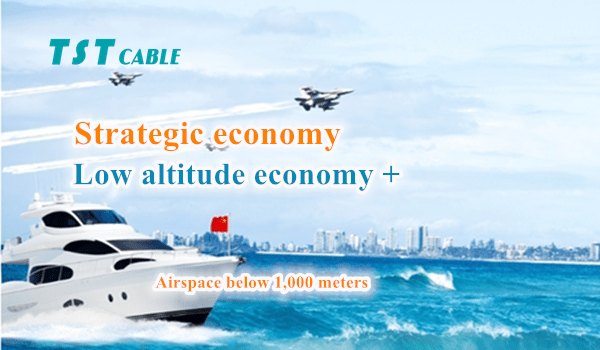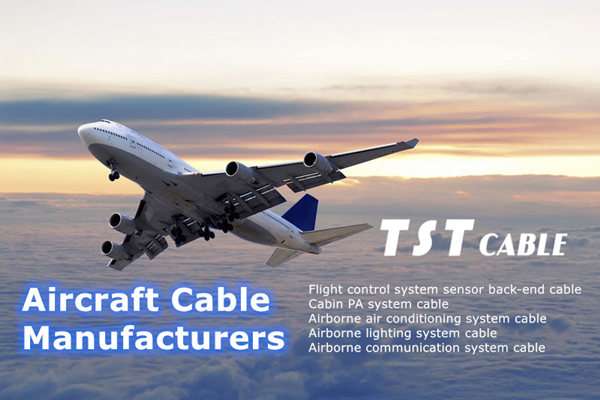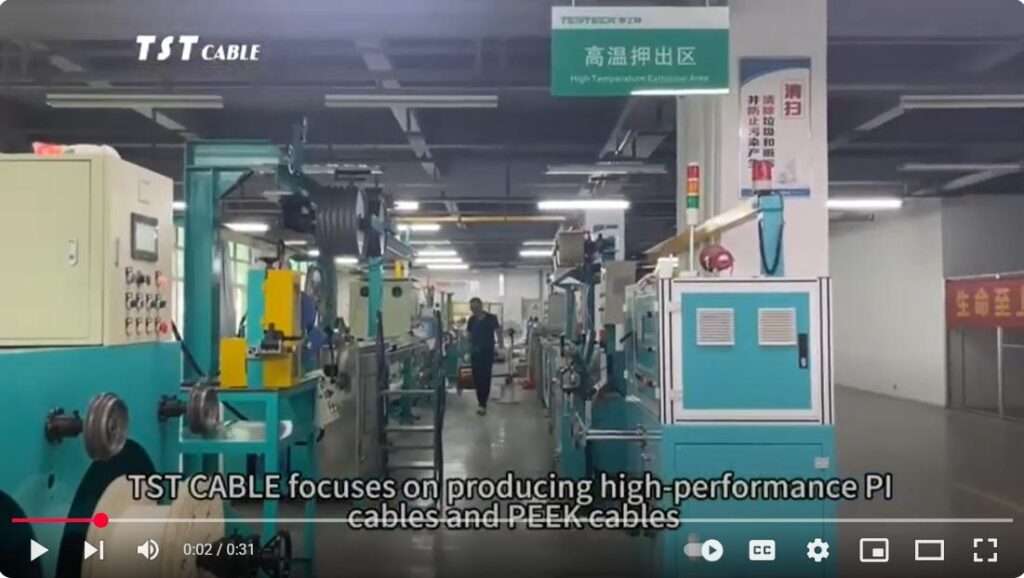TST CABLES helps low altitude economy + strategic emerging industries to land

If you don’t understand the low altitude economy now, it’s probably equivalent to 20 years ago, you didn’t understand mobile Internet, 15 years ago you didn’t understand smartphones, 10 years ago you didn’t understand short videos, the world is changing so fast that you can’t imagine it. The low altitude economy is a huge dividend of the times, do you still want to miss it? TST CABLES takes everyone to understand the opportunities and applications in the field of low altitude economy.
low altitude cultural tourism, logistics distribution, environmental monitoring, aerial photography and mapping, security inspection, urban management… At present, drones are changing people’s production and lifestyle. As an emerging industry track, the low altitude economy that “takes off with the wind” is booming everywhere. According to a relevant report from the China Academy of Information and Communications Technology of the Ministry of Industry and Information Technology, the scale of China’s low altitude economy will be 505.95 billion yuan in 2023, with a growth rate of 33.8%. According to the forecast of the Civil Aviation Administration of China, by 2025, the market size of my country’s low altitude economy will reach 1.5 trillion yuan, and by 2035 it is expected to reach 3.5 trillion yuan.
What is “low altitude economy”?
low altitude economy refers to an economic system formed by using low altitude airspace (usually refers to airspace below 1,000 meters from the ground) for various commercial activities and technological applications. With the development of drone technology, small aircraft and related infrastructure, low altitude economy is gradually becoming an important emerging field.
Main applications and development trends of low altitude economy
1. Drone delivery
Logistics and express delivery: Drones can be used for express delivery and logistics delivery, especially in remote areas or places with inconvenient transportation. For example, companies such as Amazon and JD.com are already testing drone delivery services.
Medical supplies transportation: In emergency situations, drones can quickly deliver medical supplies such as blood, vaccines and emergency medicines.
2. Agricultural applications
Precision agriculture: Drones can be used for farmland monitoring, crop spraying, soil analysis, etc. to improve agricultural production efficiency and sustainability.
Plant protection operations: Drones can accurately spray pesticides and fertilizers, reduce the use of chemicals, and reduce environmental pollution.

3. Aerial photography and surveying
Film and television shooting: Drone aerial photography technology is widely used in filming movies, TV shows and advertisements, providing unique perspectives and high-quality pictures.
Geographical mapping: UAVs can perform high-precision terrain mapping, urban planning and environmental monitoring, and provide data support for government departments and enterprises.
4. Security and monitoring
Border patrol: UAVs can be used for border monitoring and patrol to improve border security.
Public security: UAVs can be used for real-time monitoring and emergency response in large-scale events, natural disasters and emergencies.
5. Entertainment and tourism
Aerial photography: Individuals and professional photographers can use drones for aerial photography to capture unique scenery and pictures.
Tourism experience: Some tourist attractions and scenic spots provide drone sightseeing services, allowing tourists to enjoy the beautiful scenery from an aerial perspective.
6 Security and infrastructure inspection
Power inspection: UAVs can be used for inspection of infrastructure such as power lines and transmission towers to improve inspection efficiency and safety.
Bridge and building inspection: UAVs can perform non-destructive testing on bridges, high-rise buildings, etc., and promptly discover potential safety hazards.
Security emergency patrol: public security police patrol, highway patrol, fire emergency patrol, industrial park patrol, etc.
Energy facility inspection: transmission line inspection, substation inspection, distribution line inspection, photovoltaic panel inspection, etc.
Environmental governance patrol: river and lake patrol, urban management patrol, forest patrol, etc.
7. Scientific research and education
Scientific research: UAVs can be used for scientific research projects such as meteorological observation, environmental monitoring, and wildlife protection.
Education and training: The application of UAV technology also provides new tools and platforms for education and training to cultivate future scientific and technological talents.
8. Urban management
Intelligent traffic management: UAVs can be used for traffic monitoring, accident handling and congestion relief.
Environmental monitoring: UAVs can monitor air quality, water quality and noise pollution, and provide data support for urban management and environmental protection.
low altitude economic development trend
1. Technological innovation:
Autonomous flight technology: With the development of artificial intelligence and machine learning, UAVs will become more intelligent and can autonomously plan routes, avoid obstacles and perform tasks.
Battery technology: The improvement of battery life will extend the flight time of UAVs and expand their application range.
Communication technology: The development of 5G and satellite communication technology will improve the data transmission speed and reliability of UAVs.
2. Policies and regulations:
Airspace management: Governments are gradually improving the management policies of low altitude airspace and formulating drone flight specifications and standards.
Safety supervision: Strengthen the safety supervision of drones to ensure flight safety and privacy protection.
3. Market expansion:
International cooperation: The globalization trend of the low altitude economy is obvious, and international cooperation will further promote technological progress and market expansion.
Industrial chain development: The continuous improvement of the upstream and downstream industrial chains, including drone manufacturing, software development, data processing and service operations, will promote the comprehensive development of the low altitude economy.
Main applications of cable technology in the low altitude economy
The development of the low altitude economy is inseparable from the support of various technologies, among which cable technology plays a key role in drones, small aircraft and other low altitude equipment. The following are the main applications and importance of cable technology in the low altitude economy:
1. Internal wiring of drones
Power cable: Provide power connection for the drone’s battery, motor and other electronic equipment.
Signal cable: Used to transmit control signals and data to ensure the stable operation of the drone.
Data transmission cable: Connect sensors, cameras and other data acquisition equipment to achieve real-time data transmission.
2. Ground support equipment
Charging station cable: Provide power connection for drone charging station to ensure that drone can charge quickly.
Data transmission cable: Connect ground control station and drone for data exchange and remote control.
Communication cable: Used for communication between ground control station and drone to ensure reliable transmission of instructions and data.
3. Infrastructure inspection
Power inspection cable: Used for data transmission and power supply during power line inspection.
Bridge inspection cable: Connect inspection equipment and drone to transmit inspection data.
Building inspection cable: Used for inspection of high-rise buildings and complex structures, transmitting video and image data.
Security emergency patrol: Public security police patrol, highway patrol, fire emergency patrol, industrial park patrol, etc.
Energy facility inspection: Transmission line inspection, substation inspection, distribution line inspection, photovoltaic panel inspection, etc.
Environmental governance patrol: River and lake patrol, urban management patrol, forest patrol, etc.
4. Agricultural application
Plant protection operation cable: Connect spraying equipment and drone to control the spraying of pesticides and fertilizers.
Soil analysis cable: Used for data transmission of soil sampling and analysis equipment.
Crop monitoring cable: connect sensors and drones to monitor crop growth in real time.
5. Aerial photography and mapping
Camera cable: connect high-definition cameras on drones to transmit high-quality videos and images.
Mapping equipment cable: connect various mapping equipment, such as LiDAR and GPS receivers, for high-precision mapping.
6. Security and monitoring
Surveillance camera cable: connect cameras on drones to transmit real-time video data.
Infrared sensor cable: used for monitoring at night or in low-light environments, transmitting infrared image data.
Communication cable: ensure real-time communication between drones and ground control centers.
7. Logistics and distribution
Cargo transportation cable: used for control and data transmission of drone cargo loading and unloading equipment.
Navigation cable: connect navigation systems to ensure that drones arrive at their destinations accurately.
Communication cable: ensure smooth communication between drones and logistics centers.
8. Scientific research and education
Scientific research equipment cable: connect various scientific research equipment, such as meteorological observation instruments, environmental monitoring equipment, etc.
Education and training cable: used for teaching demonstrations and simulation training, transmitting teaching data and videos.
9. Intelligent Traffic Management
Traffic monitoring cable: connect traffic monitoring cameras and transmit real-time traffic data.
Communication cable: ensure smooth communication between drones and traffic management centers.
Cable technology requirements
In order to meet the various application requirements in the low altitude economy, cable technology needs to have the following characteristics:
1. Lightweight:
Use lightweight materials such as PEEK cable (polyetheretherketone cable), PI cable (polyimide cable) and silicone rubber to reduce the overall weight and increase the payload and endurance of drones.
2. High and low temperature resistance:
Use insulating materials that can work at extreme temperatures, such as silicone rubber and PTFE (polytetrafluoroethylene), to ensure the reliability of cables in different environments.
3. High flexibility:
Use soft insulation and sheath materials to improve the bending performance of the cable, facilitate installation and wiring, and have good tensile strength.
4. High reliability:
With anti-vibration and anti-shock design, it ensures that it will not be damaged by mechanical stress during flight.
Waterproof and dustproof performance, suitable for various harsh environments.
5. Electromagnetic compatibility:
Use efficient shielding technology to reduce electromagnetic interference and ensure the stability and accuracy of signal transmission.
Optimize the grounding design of the cable to improve the electromagnetic compatibility of the system.
6. Multifunctional integration:
Integrate the power line, signal line and data line in the same cable to simplify wiring and improve system integration.
Integrate sensors and self-diagnosis functions to monitor the cable status in real time and improve maintenance efficiency.
7. Environmental protection and safety:
Use low-smoke halogen-free materials to reduce harmful gases generated during fire and improve safety.
It has good flame retardant properties, can effectively suppress the spread of fire and improve the safety of cables.
The low altitude economy is an emerging field full of potential and opportunities, covering logistics, agriculture, aerial photography, security, entertainment, scientific research and other aspects. The development of the low altitude economy has put forward higher requirements for cable technology, including lightweight, temperature resistance, flexibility, high reliability, electromagnetic compatibility, multifunctional integration, environmental protection and safety. By meeting these technical requirements, cables can better support the efficient and safe operation of drones and other low altitude equipment, and promote the rapid development of the low altitude economy. For enterprises, paying attention to and investing in the research and development and application of high-performance cable technology will be an important step to seize the development opportunities of the low altitude economy. As an important part of the future space industry, the low altitude economy has become an important starting point and growth engine for promoting new industrialization, forming new quality productivity, and empowering the new economy. In the field of low altitude economy, TST CABLES has been committed to the innovation and application of aviation cables, artificial intelligence, and drone cable technologies, promoting the widespread implementation of “low altitude economy +” application scenarios, and contributing to the transformation and upgrading of industrial structure and high-quality economic development.
Also available in:
Arabic
English
Japanese
Russian
Portuguese (Brazil)





